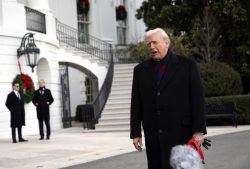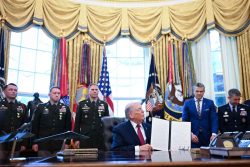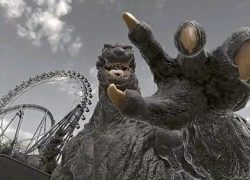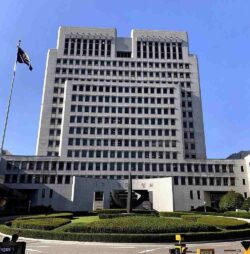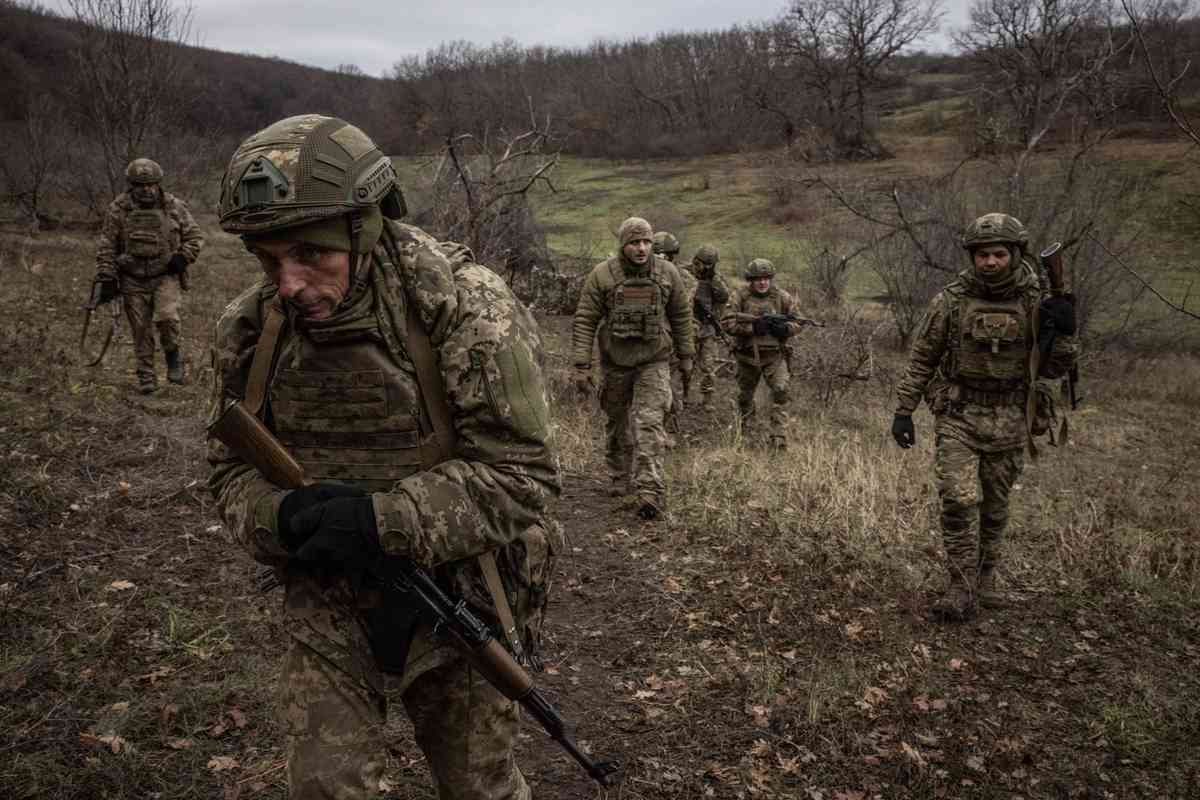
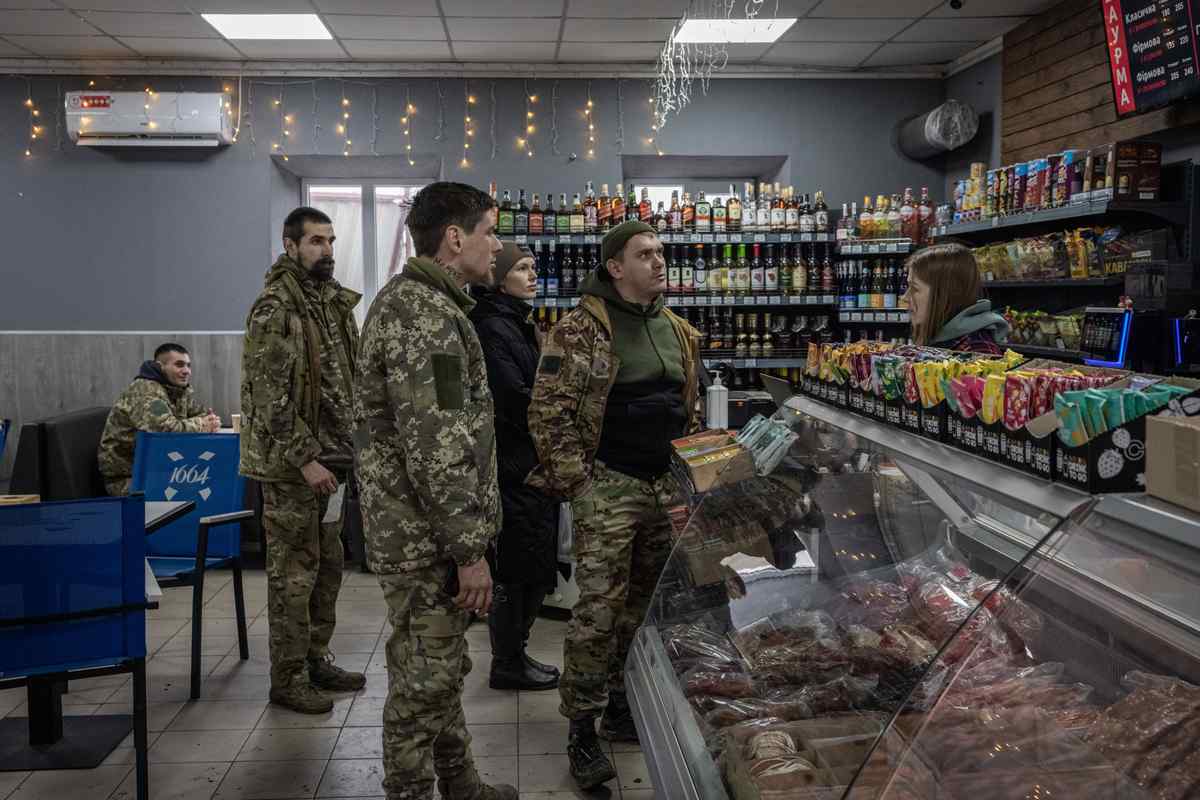
Top: Convicts who volunteered to fight for the military as part of an amnesty program participate in a fire and maneuver drill in the Donetsk region.
Bottom: Soldiers order lunch in a village in the Donetsk region on Dec. 26.
16:52 JST, January 5, 2025
DONETSK REGION, Ukraine – Russian forces in Ukraine are advancing at their fastest pace since the early days of the invasion by using the biggest advantage Moscow has in this war: manpower.
Ukrainian military personnel in the field said weapons shortages persist, but it’s the relentless human assaults that have been most effective for Russian forces exploiting vulnerabilities in Ukraine’s increasingly thin defenses.
Russian losses are very high, the Ukrainian soldiers said, but the repeated attacks supported by heavy bombardment from artillery and drones just keep coming, pushing the Ukrainians back one small piece of territory at a time. Russian forces have advanced within two miles of the eastern town of Pokrovsk, putting in peril key logistical and resupply routes that run through the area to other parts of the front line.
“You kill one Russian and it’s like two pop up in his place,” said Valentyn, an infantryman in Ukraine’s 35th Marine Brigade. Like others interviewed for this story, The Washington Post agreed to identify him by just his first name or call sign, according to rules set by Ukraine’s military. “You get this feeling there is an unlimited number of them,” he added.
At the same time, the ranks of Ukrainian soldiers have grown more and more depleted and unequipped to fend off the Russian onslaught. Those in the field describe exhaustion and slumping morale. And soldiers who said they believed in fighting until the last of the Russian occupiers were pushed off all of Ukraine’s territory are increasingly supporting President-elect Donald Trump’s call to begin negotiations to end the war.
The shift in attitude has come as Ukrainian soldiers said they have grown frustrated with their own government in Kyiv, criticizing what has been a slow and disjointed mobilization campaign. Many also said they had to invest their own money or were dependent on civilian volunteers for equipment such as drones and the vehicles they drive near front-line positions because they couldn’t rely on the government for essential equipment.
Ukraine’s parliament last year adopted new mobilization measures that lowered Ukraine’s minimum conscription age to 25. But military personnel said the draft drive came too late – when units were already severely shorthanded after months without replacements. There have been more deserters, too, they said, because people are no longer volunteering to fight but are being forced to.
“When I just got into the army, the situation was bad,” said Oleksandr, a 27-year-old infantry soldier in the 35th brigade. “But now, for a new person, the situation is so bad that I don’t judge anyone who’s deserting.”
Though Ukraine’s former military chief, Valery Zaluzhny, called for mobilizing 500,000 people in 2024, President Volodymyr Zelensky rejected that number as too high. Ukrainian and Western officials estimate that Kyiv ultimately drafted about 200,000 recruits. Zelensky has also turned back suggestions from the White House to further lower the conscription age to 18.
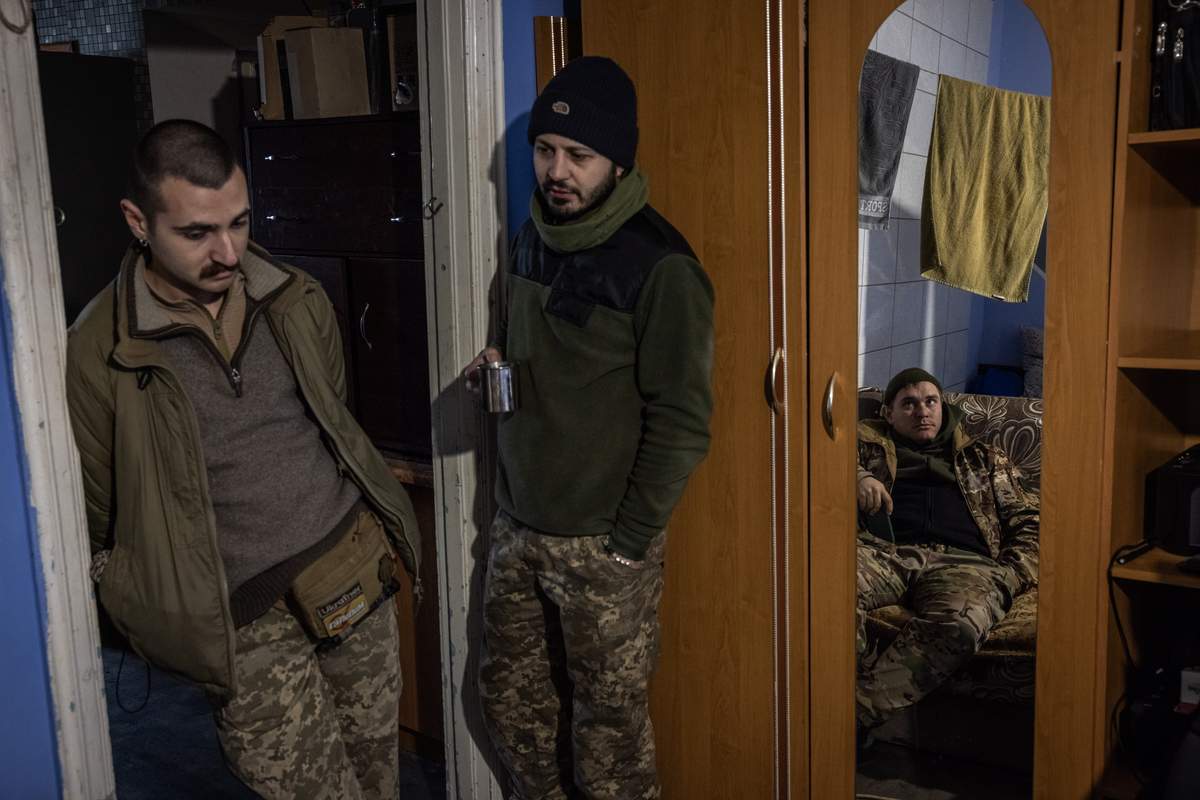
Soldiers Taras, 33, left, and Oleksandr, 27, discuss the war.
“I’m not telling you numbers, but it’s horrible,” said Taras, a deputy battalion commander fighting near Pokrovsk. “People are being called up to fight, but sadly we have losses, and these losses have to be replenished. And it’s truly not enough.”
Some soldiers said they’ve also come to terms with the reality that Western arms support has been declining and will likely continue to do so. Without the flow of that aid, Ukraine lacks the military resources to push the Russians back, the soldiers said. Russia maintains an artillery advantage and is now using new self-destructing drones that fly with the use of fiber-optic cables, making them especially deadly; they are largely invulnerable to electronic jamming, as they are controlled through long thin coils, not radio waves.
Moscow is occupying more than 20 percent of Ukraine – a large swath of territory stretching from the northeast to the Crimean Peninsula on the Black Sea in the south. Several Ukrainian military personnel said they feared the Russians would continue pushing the front line west, toward the major city of Dnipro, which has a population of approximately 1 million people.
The Washington Post interviewed Ukrainian soldiers from six different brigades fighting in eastern Ukraine for this story. Many were skeptical that Russian President Vladimir Putin would agree to a ceasefire while his troops appear to have the initiative and fear Zelensky will have to make painful concessions. Others expressed concern that even if fighting stopped this year, Russia could just attack again in the future.
“Let’s be honest, the situation now is worse than at the start of the full-scale invasion,” said 33-year-old Taras, a captain and company commander in the 35th brigade. “What can we negotiate now? We can only nod our heads and agree to their demands, and what they will demand is obviously going to be something that we don’t like.”
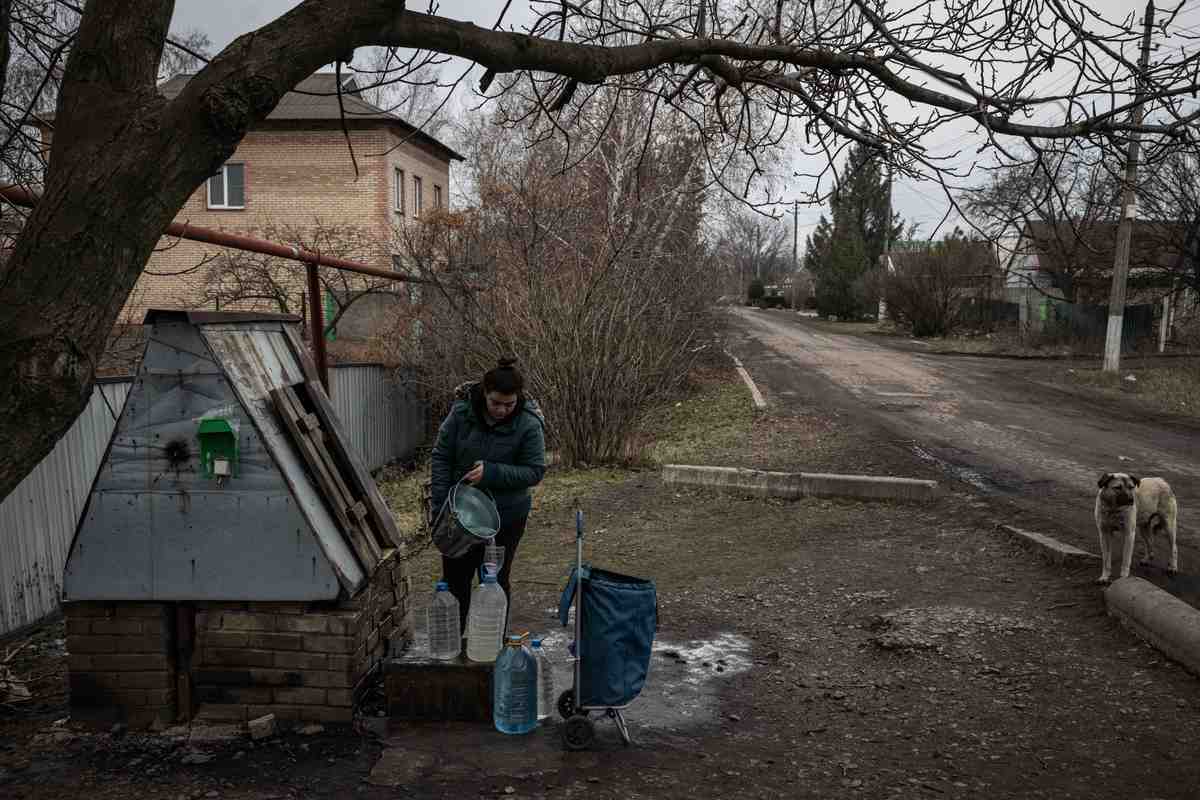
A woman fills up water bottles from a well in a village north of Pokrovsk.
Ukrainian forces can typically fend off the first assault waves, soldiers said. But the Russian strategy is based on overwhelming its enemy with greater numbers to eventually break through once their probes have identified where Ukraine has gaps in its defenses.
A tank commander in the 68th brigade who spoke on the condition he would be identified by his call sign, Physic, called the strategy “sheer madness,” as the attacking Russians likely understand their chances of survival are slim and push ahead anyway.
“Maybe one man from the third group reaches their goal,” Physic said. “He digs in there, sets up communication and coordinates the others. They gradually accumulate a critical mass of people in one place, near our positions. They endure – mortars hit them, everything imaginable targets them. They suffer heavy losses, but they persist.”
Moving in smaller groups on foot, the most-used tactic, also allows the Russians to covertly build up forces one or two people at a time before their next attack. Armored vehicles are rarely used in offensives anymore, soldiers said.
“You think everything is all right because you haven’t seen a lot of the enemy and then suddenly 10 people run out of one basement,” said Taras, the deputy commander fighting near Pokrovsk. “That happened to us recently. Where did they come from?”
Ukraine’s most acute personnel shortages are among infantry – the soldiers needed to stand in the forward-most positions. Last year, Ukraine copied one of Russia’s best recruitment tactics: releasing convicted felons who agreed to fight in high-risk assault units. But they’ve done little to plug the holes, commanders said. One officer in an interview regretted that Kyiv had waited so long to recruit inmates after Moscow did it in the first months of the war.
Volodymyr, a 33-year-old who had been serving a prison sentence for beating a man to death, was one of the first to join the 93rd Mechanized Brigade’s battalion of convicts. He’s already conducted five assaults on Russian positions. “No one forced us to fight – we volunteered – so we might be more motivated than those drafted off the street,” he added.
Ukrainian soldiers said casualties have been higher in defensive positions than when they’re on the offensive. Drone surveillance has enabled both armies to monitor any movement across the battlefield, and the greatest danger now is just getting to a position. Taras said driving any vehicle without an electronic warfare jammer to fend off drones is rarely done because the risks are so high.
“The worst is when the boys didn’t even manage to get to the position,” he said. “When you’re on the front line and you get wounded there, that’s understandable. But there are situations where people were going on a combat mission for the first time in their lives and that happened.”
The Russians’ transition to drones directed by fiber optic cables stretching up to 12 miles means jamming isn’t always effective. Oleksandr, from the 35th brigade, said he’s spotted cables on tree branches, but he couldn’t risk trying to sever them with a knife. If he were spotted, he’d almost certainly be killed with another drone, he said.
“After a mission, with all these drones, you have very high paranoia,” Oleksandr said. “Every sound, every movement, you detect that as a drone and you try to hide from it.”
In his New Year’s Eve address to Ukrainians, Zelensky’s message focused on what he called a “fair peace” – a different tone than previous calls for a total Russian defeat and restoring Ukraine’s 1991 borders established after the collapse of the Soviet Union. He has said Ukraine could end the “hot phase” of war this year and then seek the return of the occupied areas diplomatically at a later date.
“Everything is pointing in the direction” of a ceasefire, said Serhii Filimonov, the commander of the Da Vinci Wolves battalion. “A lot was influenced by the elections in the U.S. and Trump’s rhetoric.”
"News Services" POPULAR ARTICLE
-

American Playwright Jeremy O. Harris Arrested in Japan on Alleged Drug Smuggling
-

Taiwan President Shows Support for Japan in China Dispute with Sushi Lunch
-

Japan’s Nikkei Stock Average as JGB Yields, Yen Rise on Rate-Hike Bets
-

Japan’s Nikkei Stock Average Licks Wounds after Selloff Sparked by BOJ Hike Bets (UPDATE 1)
-

Japanese Bond Yields Zoom, Stocks Slide as Rate Hike Looms
JN ACCESS RANKING
-

Japan’s Hopes for Seafood Exports Shot Down in China Spat
-

Keidanren Chairman Yoshinobu Tsutsui Visits Kashiwazaki-Kariwa Nuclear Power Plant; Inspects New Emergency Safety System
-

Japan to Charge Foreigners More for Residence Permits, Looking to Align with Western Countries
-

Japan Exports Rise in October as Slump in U.S. Sales Eases
-

Govt Aims to Expand NISA Program Lineup, Abolish Age Restriction



